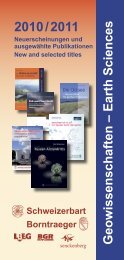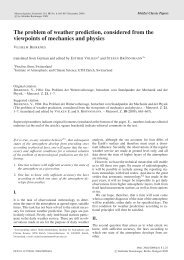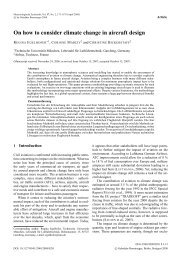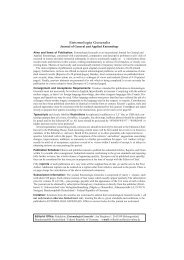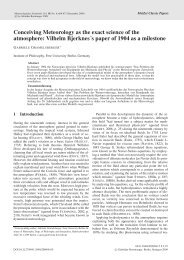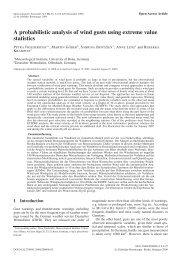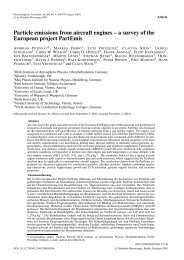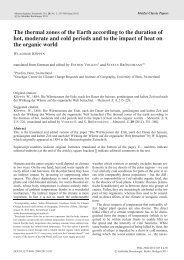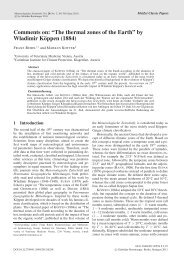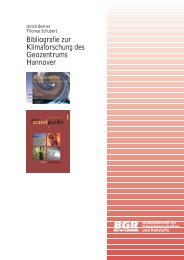Download paper for free - E Schweizerbart Science Publishers
Download paper for free - E Schweizerbart Science Publishers
Download paper for free - E Schweizerbart Science Publishers
You also want an ePaper? Increase the reach of your titles
YUMPU automatically turns print PDFs into web optimized ePapers that Google loves.
Meteorologische Zeitschrift, Vol. 20, No. 2, 091-093 (April 2011) Editorial<br />
c○ by Gebrüder Borntraeger 2011<br />
Research Results from the Priority Program SPP1167-PQP<br />
ANDREAS HENSE 1∗ , VOLKER WULFMEYER 2<br />
1 Meteorological Institute, University of Bonn, Germany<br />
2 Institut für Physik und Meteorologie, Universität Hohenheim, Germany<br />
Between April 2004 and March 2010 the “Deutsche Forschungsgemeinschaft” (DFG) funded the Priority Program<br />
1167 on Quantitative Precipitation Forecasting (QPF), also called “Precipitationis Quantitativae Predictio (PQP)”.<br />
The program committee <strong>for</strong> PP1167-PQP consisted of Andreas HENSE and Clemens SIMMER, University of Bonn;<br />
Christoph KOTTMEIER, Karlsruhe Institute of Technology KIT; Gerhard ADRIAN, German Meteorological Service<br />
(DWD); and Volker WULFMEYER, University of Hohenheim. The overall goal of PQP was the improvement of<br />
short-range to medium-range QPF in Central Europe. Specifically, the goals of the six-year research endeavour<br />
have been (I) Identification of physical and chemical processes responsible <strong>for</strong> the deficiencies in quantitative<br />
precipitation <strong>for</strong>ecast. (II) Determination and use of the potentials of existing and new data and process descriptions<br />
to improve quantitative precipitation <strong>for</strong>ecast. (III) Determination of the prognosis potential of weather <strong>for</strong>ecast<br />
models by statistico-dynamic analyses with respect to quantitative precipitation <strong>for</strong>ecast.<br />
A first comprehensive overview of the work accomplished in PP1167-PQP was presented in the first PQP special<br />
issue of Meteorologische Zeitschrift Vol. 17, No. 6 from December 2008 (HENSE and WULFMEYER, 2008).<br />
Meanwhile the total number of publications arising from the priority program has excceeded the benchmark of<br />
100 articles including those which are presented in this second PQP special issue of Meteorologische Zeitschrift<br />
(see Fig. 1).<br />
In order to bundle the research ef<strong>for</strong>ts of more than 20 projects in the PP1167-PQP and to foster synergy effects<br />
between the expertise of the various groups, steering committee decided to organize the different projects into four<br />
categories. These are the topics:<br />
1. Orography and convection<br />
2. Data assimilation and stochastic system studies<br />
3. Microphysics of clouds and aerosols<br />
4. Verification<br />
Topic 1 was chosen in view of two other international precipitation <strong>for</strong>ecasting projects: IHOP in the US<br />
focused on the physics and dynamics of precipitation in an essentially flat continental terrain and CSIP in the UK<br />
focused on the physics and dynamics of precipitation during the transition of air masses from marine to continental<br />
environments. The COPS experiment (WULFMEYER et al., 2008) in June, July and August 2007 and the GOP<br />
(CREWELL et al., 2008) in 2007 have strongly contributed to Topic (1). Another special issue with 21 articles<br />
dedicated to the results of COPS has recently been published in the Quarterly Journal of the Royal Meteorological<br />
Society (WULFMEYER et al., 2011). Within this second PQP special issue of Meteorologische Zeitschrift the reader<br />
will find five articles which contribute to topic (1). The article by BARTHLOTT et al. (2011) evaluates the importance<br />
of soil moisture in complex terrain upon deep convection. The contribution by KUNZ (2011) presents a conceptual<br />
study of the life cycle of orographically triggered convection and precipitation. KÜLL and BOTT (2011) present<br />
a novel parameterization of convection and its influence on the <strong>for</strong>ecasts of precipitation. HERBORT and ETLING<br />
(2011) analyse the spatio temporal structures of shower precipitation in <strong>for</strong>ecasts and radar observations. Finally<br />
RUPRECHT and KLEIN (2011) present a theoretical study of the interaction of gravity waves with convective clouds.<br />
Topic 2 was selected based on the assumption that research at the interface of observations and dynamical<br />
models using modern data assimilation techniques was still in the fledgling stages in Germany at the beginning of<br />
the priority program in 2003/04. It is this desideratum that the respective research ef<strong>for</strong>ts were meant to counter.<br />
Closely connected to the problem of data assimilation is the generation and interpretation of ensemble weather<br />
<strong>for</strong>ecasts. Accordingly the reader will find four articles in the present special issue: WEUSTHOFF et al. (2011)<br />
deal with the problem of weighting single realisations of an ensemble <strong>for</strong>ecast using observations while KEIL and<br />
CRAIG (2011) study the growth of uncertainty and the predictibility of convective precipitation using ensemble<br />
∗ Corresponding author: Andreas Hense, Meteorological Institute, University of Bonn, Auf dem Hügel 20, 53121 Bonn, Germany, e-mail: ahense@uni-<br />
bonn.de<br />
0941-2948/2011/0517 $ 1.35<br />
DOI 10.1127/0941-2948/2011/0517 c○ Gebrüder Borntraeger, Berlin, Stuttgart 2011
92 A. Hense & V. Wulfmeyer: Editorial Meteorol. Z., 20, 2011<br />
Figure 1: Number of publications per year originating from the work in the PP1167-PQP<br />
weather <strong>for</strong>ecasts of the COSMO-DE model. ZUS et al. (2011) present an analysis of assimilating GPS based<br />
water vapour in<strong>for</strong>mation into the MM5 model. CLAUSSNITZER et al. (2011) present their results on the latent heat<br />
nudging technique of radar observations into the COSMO regional weather <strong>for</strong>ecast model.<br />
Topic 3 was the smallest one with respect to the number of participating projects. Nevertheless it made important<br />
contributions to the scientific objectives I and II stated above. This achievement became possible through the<br />
international cooperation during the COPS campaign. Within this special issue the work by BÖHME et al. (2011a)<br />
presents a verification analysis of regular COSMO <strong>for</strong>ecasts using remote sensing observations concentrating on<br />
the microphysical properties.<br />
Topic 4 covered the validation of weather <strong>for</strong>ecasts. Although this has been a key issue in operational<br />
meteorology <strong>for</strong> decades, methods <strong>for</strong> validating ensemble <strong>for</strong>ecasts and their so-called predictive probabilities<br />
had not been investigated in depth be<strong>for</strong>e the start of the priority program. KELLER and HENSE (2011) present<br />
a novel method to summarize the probabilistic quality of ensemble <strong>for</strong>ecasts. Another point which had not been<br />
fully addressed in literature was the validation of field data to make statements about the statistical comparison of<br />
spatio-temporal structures or patterns in <strong>for</strong>ecasts and observations. ZIMMER and WERNLI (2011) use specifically<br />
designed metric to characterize the similarity or dissimilarity of precipitation <strong>for</strong>ecasts and observations. A further<br />
aspect was the need to validate weather <strong>for</strong>ecasts and the respective models with respect to model physics or/and<br />
to take advantage of the high spatio-temporal resolution of remote sensing instruments like radars or satellites in<br />
combination with classical measurements. An application can be found in BÖHME et al. (2011b)<br />
Again we are convinced that this second special issue of the Meteorologische Zeitschrift on quantitative<br />
precipitation <strong>for</strong>ecasting represents a highly advanced state of research on QPF and hope that it will find many<br />
readers all over the world.<br />
References<br />
BARTHLOTT, C.,C. HAUCK, G. SCHÄDLER, N. KALTHOFF, C. KOTTMEIER, 2011: Soil moisture impacts on convective<br />
indices and precipitation in complex terrain. – Meteorol. Z. 20, 185–197.<br />
BÖHME, T., N. VAN LIPZIG, L. DELOBBE, E. GOUDENHOOFDT, A. SEIFER, 2011a: Evaluation of microphysical assumptions<br />
of the COSMO model using radar and rain gauge observations. – Meteorol. Z. 20, 133–144.<br />
BÖHME, T., S. STAPELBERG, T. AKKERMANS, S. CREWELL, J. FISCHER, T. REINHARDT, A. SEIFERT, C. SELBACH, N.<br />
VAN LIPZIG, 2011b: Long-term evaluation of COSMO <strong>for</strong>ecasting using combined observational data of the GOP period.<br />
– Meteorol. Z. 20, 119–132.<br />
CLAUSSNITZER A., T. SCHARTNER, P. NÉVIR, K. STEPHAN, U. CUBASCH 2011: The data assimilation method “Latent<br />
Heat Nudging” assessed with the Dynamic State Index – Meteorol. Z. 20, 165–172.<br />
CREWELL, S., M. MECH, T. REINHARDT, C. SELBACH, H.D. BETZ, E. BROCARD, G. DICK, E. O’CONNOR, J.<br />
FISCHER, T. HANISCH, T. HAUF, A. HÜNERBEIN, L. DELOBBE, A.MATHES, G. PETERS, H. WERNLI, M. WIEGNER,<br />
V. WULFMEYER, 2008: The general observation period 2007 within the priority program on quantitative precipitation<br />
<strong>for</strong>ecasting: Concept and first results. – Meteorol. Z. 17, 849–866.<br />
HENSE, A., V. WULFMEYER 2008: The German Priority Program SPP1167 “Quantitative Precipitation Forecast”. –<br />
Meteorol. Z. 17, 703-705
Meteorol. Z., 20, 2011 A. Hense & V. Wulfmeyer: Editorial 93<br />
HERBORT, F., D. ETLING 2011: Post-frontal shower cells in the COSMO-DE model. A comparison with radar measurements.<br />
– Meteorol. Z. 20, 217–226.<br />
KEIL, C., G. CRAIG 2011: Regime-dependent <strong>for</strong>ecast uncertainty of convective precipitation. – Meteorol. Z. 20, 145–151.<br />
KELLER, J.D., A. HENSE, 2011: A new non-Gaussian evaluation method <strong>for</strong> ensemble <strong>for</strong>ecasts based on analysis rank<br />
histograms. – Meteorol. Z. 20, 107–117.<br />
KÜLL, V., A. BOTT, 2011: Simulation of non-local effects of convection with the hybrid mass flux convection scheme<br />
HYMACS. – Meteorol. Z. 20, 227–241.<br />
KUNZ, M., 2011: Moist dynamics and sensitivity of orographic precipitation to changing ambient conditions in an idealised<br />
perspective. – Meteorol. Z. 20, 199–215.<br />
RUPRECHT, D., R. KLEIN, 2011: A model <strong>for</strong> nonlinear interactions of internal gravity waves with saturated regions. –<br />
Meteorol. Z. 20, 243–252.<br />
WEUSTHOFF, T., D. LEUENBERGER, C. KEIL, GEORGE C. CRAIG, 2011: Best Member Selection <strong>for</strong> convective-scale<br />
ensembles. – Meteorol. Z. 20, 153–164.<br />
WULFMEYER, V., A. BEHRENDT, H.-S. BAUER, C. KOTTMEIER, U. CORSMEIER, A. BLYTH, G. CRAIG, U. SCHUMANN,<br />
M. HAGEN, S. CREWELL, P. DI GIROLAMO, C. FLAMANT, M. MILLER, A. MONTANI, S. MOBBS, E. RICHARD,<br />
M.W. ROTACH, M. ARPAGAUS, H. RUSSCHENBERG, P. SCHLÜSSEL, M. KÖNIG, V. GÄRTNER, R. STEINACKER, M.<br />
DORNINGER, D.D. TURNER, T. WECKWERTH, A. HENSE, C. SIMMER, 2008: The Convective and Orographicallyinduced<br />
Precipitation Study: A Research and Development Project of the World Weather Research Program <strong>for</strong> improving<br />
quantitative precipitation <strong>for</strong>ecasting in low-mountain regions. – Bull. Americ. Meteor. Soc. 89, 1477–1486<br />
WULFMEYER, V. and 56 coauthors, 2011: The Convective and Orographically Induced Precipitation Study (COPS): The<br />
Scientific Strategy, the Field Phase, and First Highlights. COPS Special Issue Quart. J. Roy. Meteor. Soc. 137, 3–30.<br />
ZIMMER, M., H. WERNLI, 2011: Verification of quantitative precipitation <strong>for</strong>ecasts on short time-scales: A fuzzy approach<br />
to handle timing errors. – Meteorol. Z. 20, 95–105.<br />
ZUS, F., J. WICKERT, H.-S. BAUER, T. SCHWITALLA, V. WULFMEYER, 2011: Assimilation of GPS slant path data with<br />
MM5 4DVAR system. – Meteorol. Z. 20, 173–184.



